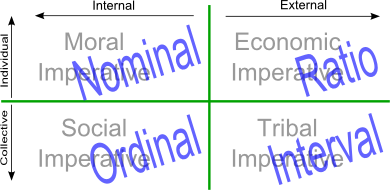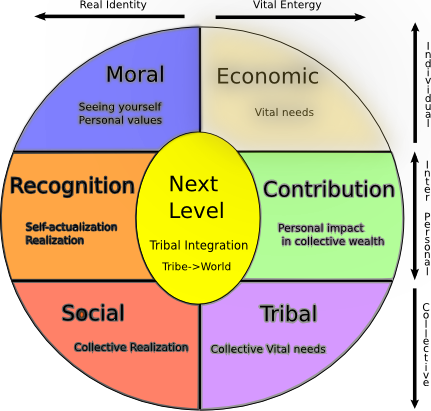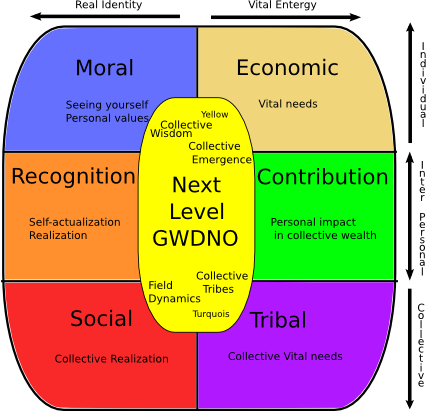Dimensions of Incentives
(This text is excerpted from Arthur Brock's OS-Earth presentation to Omidyar Network, March 2004.)
Layers and Dimensions of Human Incentives
There are multiple layers that are each simultaneously present in motivating people and groups. As humans, we have an innate drive to learn - about our surrounding and the social settings in which we operate. We also have a deep connection to the experience of fun and pleasure which keeps us coming back for more.
Today, I'm going to focus on the Survive & Thrive layer of incentives and how currencies connect to each of these the multiple dimensions of human incentives in specific ways.
This diagram (originally inspired by Ken Wilber's quadrants in Integral Theory) represents four quadrants of imperatives that are at work at all times. All these quadrants hold sway over people yet the strength of influence of certain quadrants varies according stages of personal development and worldview.
Economic Imperative [Individual & External] Motivations that relate to our own physical survival. Here we address our needs for food, clothing, and shelter, sex and safety. This is about our motivation to work for our personal economic benefit.
Tribal Imperative [Collective & External] The physical needs of our community, which often involves putting the needs of others ahead of our personal needs. We forego personal gain to take care of others because we know that our 'tribe' also takes care of us when we are in need.
Social Imperative [Collective & Internal(ized)] Our drive to be accepted and held in high regard within our community. This is about your status -- the judgments people make about the clothes you wear, the car you drive, the language you use, and the way you behave.
Moral Imperative [Individual & Internal(ized)] Our drive to do what is right and behave consistent with our beliefs about who we are. We have a sense of what is right and wrong, good and bad, and we need to perceive ourselves as somehow aligned with right and good part of that equation.
Illustrative story from Freakonomics (added in 2005)
In the book Freakonomics, there is a story which provides a vivid depiction of these imperatives in action. There's a day care center in Haifa, Israel struggling with parents picking up their children late. They have no provisions for afterschool care, so late arrivals inconvenience the staff and keep children and teachers waiting at the curb.
They seek advice from some economists and to them the solution seem simple. Charge the latecomers a fine.
They decide to do a study and measure frequency of late pickups before and after the introduction of new fees. And what do you suppose were the results of their plan?
The problem tripled!
The economists were shocked by the outcome. The day care center decided they would do better to remove the fines, but it was too late. Having established their financial value, the late pickups remained at the elevated level. The authors of Freakonomics mention that there must be other unknown forces at work that were alleviated by by introducing the fines...maybe moral or social pressures that were unaccounted for.
I'm stating unequivocally that this is the case. The parents had an internalized moral imperative to be "good" parents, they had a social imperative to not look worse than the other parents and be judged poorly, they had a tribal imperative to take care of the teachers who took care of their children. As soon as a modest monetary/economic value was placed on coming late, it largely relieved them of these other pressures allowing them a guilt-free late arrival.
We have a cultural malady of validating the primacy of the economic quadrant. This leads to innapropriate translations across the quadrants. When Ford decided it would be cheaper to settle the law suits than to recall the Pintos which were exploding and burning people alive, you could say they were innappropriately abandoning moral, social and tribal responsibilities for only economic advantage.
Maybe if we had currencies which made the impact in the other quadrants as tangible as economic impacts, we could address the pandemic of such externalities which plague our society and planet. (See Threebles.com for an example of steps in this direction.)
The Connection to Different Levels of Consciousness in Spiral Dynamics
I mentioned that the strength of influence of the dimensions changes based on your level development and worldview. This next diagram includes the colors used to name each level of consciousness in Spiral Dynamics, and connects them with these dimensions of incentives. (This image provides a nice summary of spiral dynamic levels.)
The first level of consciousness is the Beige Meme, found in the upper right corner. This is about basic human survival where food, warmth, sex and safety have priority.
Next is the Purple Meme. A tribal consciousness rooted rituals, magic and tradition - providing for collective safety and belonging in the community.
On the bottom left corner is level three, the Red Meme. This level focuses on heirarchies and determining the pecking order where the strongest survive. The military, with such careful attention to rank, is a good example of the Red Meme being manifested.
Next is the Blue Meme, where you make rules to institutionalize your morality. You see it in standard education, organized religion, and the government. In many ways the founding of America was a strong Blue Meme act -- creating checks and balances to protect against the abuses of power of Red Meme folks like King George. It is also the context for much of the "Christian Right" where, for example, people who believe abortion is wrong don't just choose not to do it, they want to make it illegal for anyone else to do it.
The next levels cross two dimensions in a self-reinforcing feedback loop. Level 5, the Orange Meme, manifests in individuals striving to be 'the best.' I think of Ayn Rand's Objectivism as the flag-bearers for this level. It is the meme that has dominated modern society and you can recognize the importance of these quadrants in a funny word we use to refer to somebody's status in our society...their "socio-economic" class.

The next shift expands concerns beyond personal achievement toward the good of the larger whole. The Green Meme is driven by an individual's moral sense of what's right and wrong and its connection to the needs of the community (tribe). We recognize groups of these people among human rights movements, environmental activism, Cultural Creatives, and socially responsible enterprises.
The next level makes the leap to the second tier in Spiral Dynamics marking a point in consciousness where all the strengths and weaknesses of the previous levels can be accepted. The Yellow Meme recognizes the world as being prone to chaos and change, and allows for flexibility and responsibility in relating to it.
Not depicted here is the Turquoise Meme where, ideally a currency practitioner is standing, to design currencies which resonate with the consciousness and imperatives of all the prior levels.
How Different Currencies Connect to Different Levels
So you're thinking "These concepts are all well and good, but how do they make any difference with currencies?"
Let's revisit our definition of currency:
Currency:A formal symbol system for shaping, enabling, and measuring currents (or flows)
"A Formal System:" We're so used to relating to currencies as money that we take the method of that money formalization uses for granted. However, there are numerous different approaches available to us and each approach resonates with the quadrants differently.
Let's start with Stevens' levels of measurement, map them to each of the quadrants and look at some examples of how different currencies use them. There are real social effects to the choices we make here.
- Nominal: Able to be named / identified (e.g. Employee of the Month, President of U.S.)
- Ordinal: Able to be ranked (e.g. Percentile, Olympic Medals)
- Interval: Counted or measured in whole units (e.g. Cows, Trees, Votes)
- Ratio: Counted in divisible/infinitessemal parts (e.g. Pounds of Beef, Board feet of lumber, Dollars/cents/fractions of cents)

Consider these different ways of "formalizing."
Moral / Nominal
. . . . . She's an "A" student. . . . . . She is her Class Valedictorian.
Social / Ordinal
. . . . . She scored in the 99th Percentile. . . . . . She's in the top 10% of her class
Tribal / Interval
. . . . . She got 32 of the 34 questions correct. . . . . . Ten students missed class today.
Economic / Ratio
. . . . . She scored 94.1% on the test. . . . . . 12% Interest, compounded daily
We're used to thinking of many of these things as equivalent. Although some of them may be mathematically equivalent, they do not produce the same emotional relationship to the information. When you design a currency, it's very important to be sure that the methods of formalization you use create emotional resonance with the appropriate quadrants of your userbase. This can be a make or break difference for the success of your currency.
This is a brief glimpse at how the design of a currency can be tailored to the level of consciousness of its users. There too many decision points in currency design to detail them all. But it may be worth noting that these formalization methods also connect to the Levels of Wealth.
Footnote for those wanting to go deeper...
The next diagram expands the quadrants to include how we interact with people we know and love. We add the Inter-personal layers identified as the Appreciation Imperative (doing good works to experience yourself as being known by others) and the Contribution Imperative (doing something so that you can see the impact out there)

Additional Contributions from Readers:
An evolution of some of the images above:

Worked on if further, developing the center (transition to next tier).
